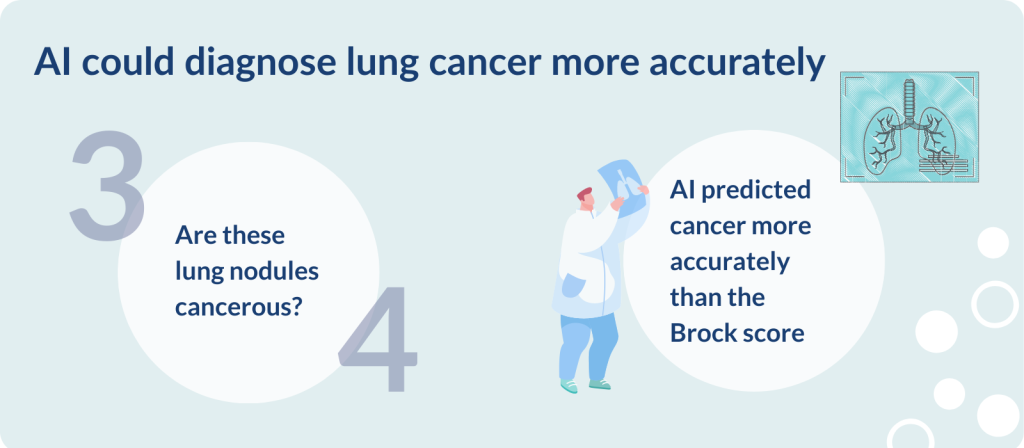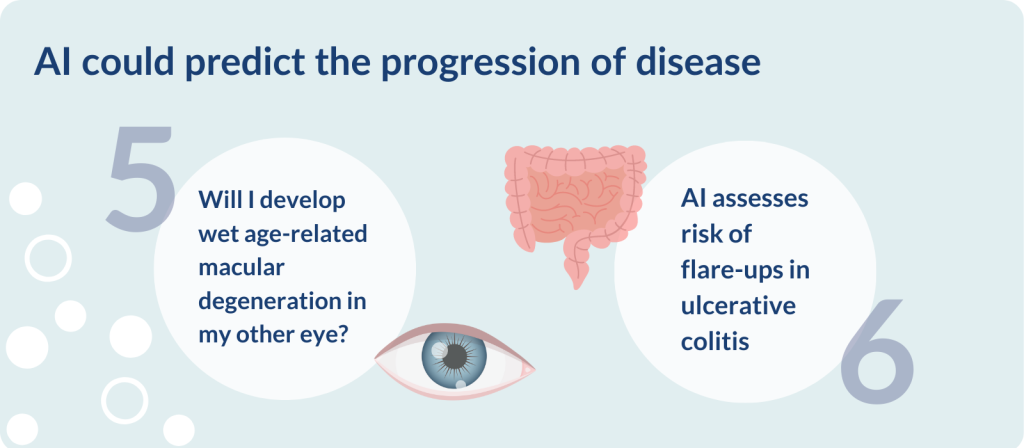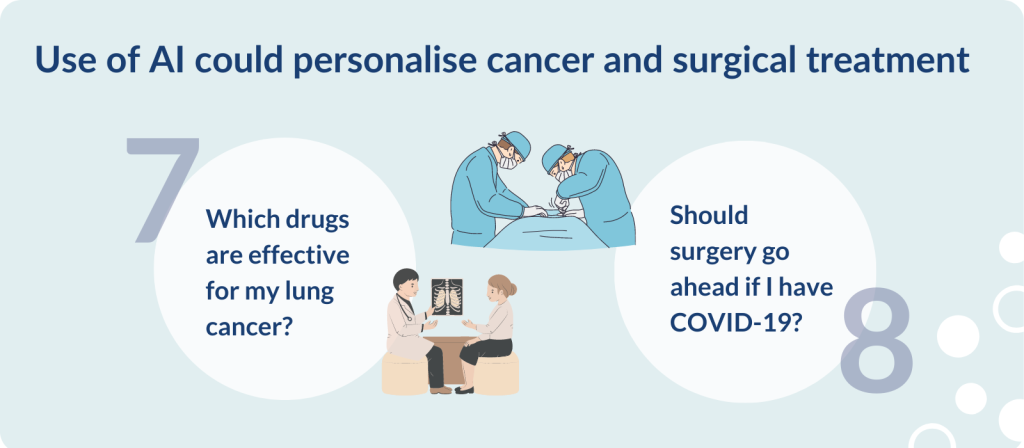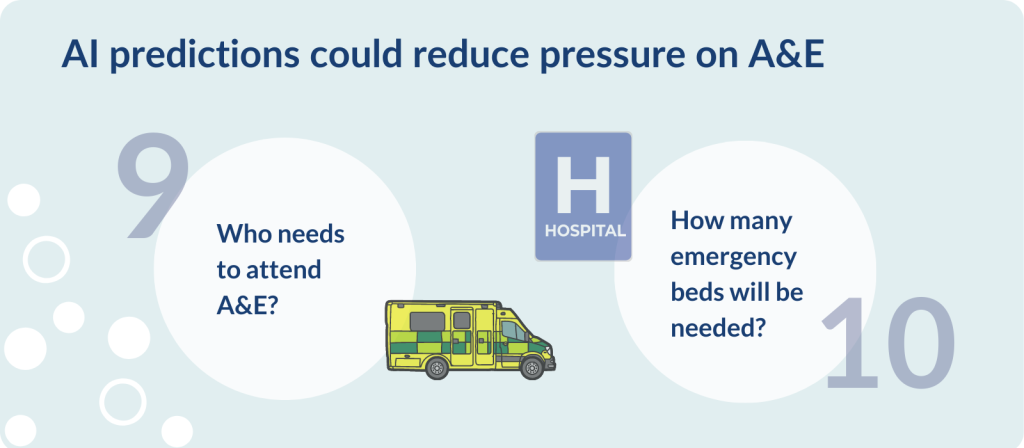The news is full of stories on artificial intelligence, or AI. These include extreme predictions about its impact on jobs, privacy and society, as well as exciting stories about benefits in healthcare and education, for example. Articles may be misleading, and exaggerate both the positive and the negative. At a time when people need to understand a rapidly-changing landscape, there is a need for debate informed by evidence. This Collection aims to provide some of that evidence.
We describe recent examples of research on AI-based technology that could support the NHS. As it develops and is put into practice, it could enable managers to predict patients’ needs and manage their service’s capacity. It could help doctors diagnose conditions earlier and more accurately, and offer specific treatments to individuals. More research is needed, but the evidence to date is promising.
The Collection provides members of the public and healthcare professionals with insights into the future of AI in healthcare.
What is AI?
 Artificial intelligence (AI) systems use digital technology to perform tasks that were once thought to require human intelligence. Face recognition and navigation systems are everyday examples.
Artificial intelligence (AI) systems use digital technology to perform tasks that were once thought to require human intelligence. Face recognition and navigation systems are everyday examples.
In most AI systems, computer algorithms examine large amounts of data, find common patterns, learn from the data and improve with time. Today, there are two main types of AI:
- Generative AI (including Chat-GPT), which can create new content – text, images, music, and so on – based on learned patterns
- Predictive AI, which can make accurate predictions and estimations about future events based on vast amounts of historical data.
Most healthcare applications are predictive AI systems, based on carefully-selected data from hospitals and research trials. These applications can help identify people at high risk of developing certain conditions, diagnose diseases, and personalise treatments. AI applications in healthcare have the potential to bring benefits to patients, professionals and the health and social care system.
AI can analyse and learn from vast quantities of complex information. It could lead to faster, more accurate diagnoses, predict the development of disease, support doctors with treatment decisions, and help manage the demand for hospital beds. But concerns about how it might be used include risks to privacy and distortions to decision making.
The UK has a rich source of national health data which is ideal for developing AI tools, but we need to be sure that AI is safe, transparent and fair. Access to data needs to be regulated; our data must be kept secure. Innovations need to be based on data from larger and more varied sources to improve algorithms. Some early AI did not account for the diversity of our population, which led to poor applications. This is now recognised and is being addressed by researchers.
We need to be able to trust AI, and ensure that it does not increase existing inequalities in care. A recent study explored how to develop AI innovations that do not embed these inequalities. And the NHS workforce needs to be ready for AI, and to understand its potential impact on care pathways and users. Research is essential if we are to realise AI’s potential.
The NHS Long Term Plan promotes AI as one type of digitally-enabled care that helps clinicians and supports patients. Regulators and public bodies have set safety standards that innovations must meet. The Government has developed a National AI Strategy and provided research funding through the NIHR. Most of the studies it has funded are ongoing or yet to publish. They range from the development of AI through to real-world testing in the NHS.
In this Collection, we bring together 10 examples of NIHR research on AI applications that show promise. All were published in the last 3 years. The research addresses 5 key areas of healthcare:
- AI could help doctors detect heart disease
- AI could diagnose lung cancer more accurately
- AI could predict the progression of disease
- Use of AI could personalise cancer and surgical treatment
- AI predictions could reduce pressure on A&E
AI could help doctors detect heart disease

Heart failure means that the heart is too weak to pump blood around the body efficiently. It is a growing health issue made worse by late diagnosis. Around 1 in 100 adults have heart failure, rising to 1 in 7 people over the age of 85. The NHS Long Term Plan highlighted that 80% of people with heart failure are diagnosed in hospital, even though many of them (40%) have symptoms that should have triggered an earlier assessment.
An easy-to-use ‘smart’ stethoscope could help doctors detect heart failure earlier. Research compared the accuracy of the new technology, which uses AI, with the standard echocardiogram, which is usually carried out in hospitals or specialist clinics. More than 1,000 people from across London took part.
"There’s currently no cure for heart failure, and so quick detection and treatment is key. This AI tool could fast-track people to get an earlier diagnosis, giving them access to life saving treatments and support much sooner."
Nick Mills, British Heart Foundation, Professor of Cardiology at the University of Edinburgh
The smart stethoscope identified people with heart failure correctly 9 out of 10 times. Few were missed by the stethoscope, and few were incorrectly identified as having heart failure when they did not. Neither age, sex, nor race affected the smart stethoscope’s ability to detect heart failure. The researchers say that GPs could use the smart stethoscope to detect heart failure, rather than having to refer people to secondary care. This could improve outcomes for patients and save the NHS money.
Another study found that AI could identify whether people attending A&E with a possible heart attack had indeed experienced one.
In England, around 1000 people a day attend A&E for a heart-related reason. A heart attack is a medical emergency and occurs when blood flow to the heart is suddenly blocked. Around 1 in 10 people who attend A&E with a suspected heart attack are found to have had one.
The study involved data from more than 20,000 people; data from half the group was used to develop and train the AI, data from the other half was used to check it. The AI took account of people’s age, sex, time since symptoms started, other health conditions and routine blood measurements. When used in conjunction with a blood test that measures heart muscle damage, it successfully identified those who had - or had not had - a heart attack. It performed better than standard methods for subgroups of people, including women, men, and older people.
The researchers say that it could be used as a clinical decision support tool. It could help reduce the time people spend in A&E, prevent unnecessary hospital admission for those unlikely to have had a heart attack and at low risk of death, and improve the early treatment of heart attacks. This would have benefits both for patients and for the NHS.
AI could diagnose lung cancer more accurately

Lung cancer is the most common cause of cancer death in the UK, with around 35,000 deaths every year. Two recent studies reported that AI could help determine whether or not lung nodules (abnormal growths) seen on a CT scan, are cancerous. Lung nodules are common and are found in up to 35 of every 100 people who have a CT scan. Most nodules are not cancerous.
One study focused on small nodules (5-15 mm across) from more than 1100 patients; the other looked at large nodules (15-30 mm) from 500 patients. The two studies used different types of AI. Each compared their technique to the standard Brock score recommended by the British Thoracic Society (which combines patient information and nodule characteristics to predict which nodules are likely to be cancerous).
Both types of AI predicted cancer more accurately than the Brock score. They could support clinicians’ timely decision making and improve patient care and outcomes. For small nodules, the researchers say their AI also has the potential to identify low-risk nodules and thus avoid repeated (surveillance) CT scans. This would save NHS resources and money. A further study has been funded to confirm real world performance.
AI could predict the progression of disease

Eye disease
Wet age-related macular degeneration (wet AMD) leads to loss of central vision. It is the biggest cause of sight loss in the UK. Development of the condition can be rapid and treatment success is dependent on early diagnosis and intervention. If the disease progresses to both eyes, people may be unable to read, recognise faces, drive or carry out other everyday activities.
“If preventative or early treatments for wet macular degeneration become available this could be a useful method to select the people who should be treated. It would be important that the AI algorithm is available on the OCT machine itself, or is easily connected, so that a report can be generated in a timely and easy way.”
James Talks, Consultant Ophthalmologist, Royal Victoria Infirmary, Newcastle upon Tyne
Around 1 in 4 people with wet AMD are expected to develop it in their second eye. But it is not currently possible to predict if or when wet AMD will affect the second eye. Analysing scans is time consuming, and this can contribute to delays in diagnosis and treatment. AI can more accurately predict than doctors whether people with wet AMD in one eye will develop it in the other eye.
The study included digital eye scans from more than 2,500 people with wet AMD in one eye. The AI model and clinical experts predicted whether patients would develop wet AMD in their second eye, within 6 months of the scan. AI correctly predicted the development of wet AMD in 2 in 5 (41%) patients. It out-performed 5 out of 6 experts.
This is the first example of AI being used to group patients according to their risk of developing a condition (risk stratification). The study found that an AI model was more accurate than doctors and opticians attempting the same task, even though they had access to more information about the patients.
Risk stratification is important for helping hospitals to direct resources towards the patients who need them most. For patients, early intervention for wet AMD can minimise sight loss, which reduces the impact it will have on their lives, and ultimately on society as a whole.
Ulcerative colitis
"AI presents many exciting opportunities for analysing images and data to improve both the treatment and diagnosis of long-term conditions. It is a powerful tool with potential to help patients with inflammatory bowel disease such as colitis."
Sarah Sleet, CEO of Crohn's & Colitis UK
Ulcerative colitis is a long-term condition that causes inflammation and ulcers in the bowel. Around 296,000 people in the UK have been diagnosed with the condition. Symptoms often come and go; people may go for weeks or months with mild symptoms, or none at all (remission). This may be followed by periods when the symptoms are particularly troublesome (flare-ups). Doctors take biopsies (a small sample of bowel) from different parts of the bowel to look at disease activity. The assessment of the biopsies is time-consuming, and professionals often come to different conclusions. Researchers developed an AI tool that could predict flare-ups and detect disease activity in people with ulcerative colitis.
This study was based on nearly 700 digitised biopsies, from 331 patients, to train, test and check the tool. AI accurately distinguished between remission and disease activity more than 8 times out of 10. With a similar degree of accuracy, and comparable to pathologists, it predicted inflammation (and therefore risk of flare-up) in the area where the biopsies were taken. The researchers say the technology could speed up and standardise assessment of ulcerative colitis, and provide accurate information about prognosis to doctors.
Use of AI could personalise cancer and surgical treatment

Which drugs are effective for my lung cancer?
Lung cancer is the most common cause of cancer death in the UK. Patients whose lung cancer has specific genetic features may benefit from targeted drug treatments.
AI could help doctors decide which specific drug combinations are likely to benefit a patient with lung cancer in as little as 12 to 48 hours. The new technology works in two stages. It predicts, first, how sensitive tumour cells are to individual cancer drugs, and then how they will respond to combinations of drugs.
AI predicted individual drug responses more accurately than is currently possible using these genetic features. It also identified new drug combinations that could be effective. The study was small but shows ‘proof of concept’ for AI used in this way. The researchers say it could inform clinical decision making and allow doctors to personalise treatment within 2 days of a tumour biopsy. If developed further, this methodology could potentially improve the outcomes of patients with lung cancer treated with targeted anticancer drugs.
Should surgery go ahead if I have COVID-19?
“We were not surprised that the tool is accurate. But we hadn’t expected to find that so few factors could predict someone’s risk. In fact, the four that emerged from this research are very easy to find out from patients or their records, so this outcome is better than we thought.”
Elizabeth Li, Surgical Registrar, University of Birmingham
People who have COVID-19 around the time of surgery have higher rates of death than those without the virus. They also have more lung-related complications afterwards. A tool to predict each patient’s risk is urgently needed. An AI tool can predict the risks of surgery for people with COVID-19. This international study used data from almost 8500 patients to develop and check their AI tool. All had contracted COVID-19 around the time of their surgery (in the 7 days before or the 30 days afterwards).
Researchers found that only 4 factors were needed to predict a patient’s risk of death within 30 days. These included the patient’s age, and whether they needed ventilation or other respiratory support before surgery. Decisions to undertake surgery always balance risks and benefits. This tool gives clinicians more information to guide discussions with patients and inform the management of their care. It is free for surgical teams to use.
AI predictions could reduce pressure on A&E

Who needs to attend A&E?
Ambulances in England take around 350,000 people a month to A&E. AI could help paramedics predict who does not need to go to A&E. Ambulance transport decisions are hard to make, but avoiding unnecessary attendance at A&E would help the service run more smoothly.
Researchers used more than 100,000 linked ambulance and A&E care records from across Yorkshire to develop an AI computer model. In 8 out of 10 times, it correctly predicted which people did not need to attend A&E. Factors such as a patient’s mobility, observations (pulse and blood oxygen, for example), allergic reactions and chest pain were all important in predicting avoidable attendance at A&E. The model was fair, and worked equally well regardless of people’s age, gender, ethnicity or where they lived. However, before being used in practice, there would need to be a more robust definition of what an avoidable trip to A&E is, the researchers say.
How many emergency beds will be needed?
AI could help predict how many patients in A&E need to be admitted. This could help planners manage the demand for beds.
Researchers developed an AI tool using data from more than 200,000 A&E visits to a busy London teaching hospital, before and during COVID-19. The tool uses data on a person’s age, test results, how they arrived at A&E, and other factors to predict whether they will be admitted to hospital.
Using real-time data from patients in A&E, the tool predicted how many hospital beds were needed in 4 and 8 hours’ time. The estimates outperformed the hospital’s usual planning of emergency admissions, which is based on the number of beds needed in the previous 6 weeks. The research was co-designed with bed managers so the tool met their needs.
Conclusion
The 10 examples in this Collection are a small but current sample of the research addressing important health challenges. They add to the mounting body of evidence demonstrating the benefits that this digitally enhanced analytical capacity can bring to the NHS. Earlier studies have already helped GPs identify patients at risk of cancer in primary care and provided specific tools to help better identify those at high risk of colon cancer and skin cancer.
The research demonstrates that AI has the potential to enable services to be more efficient and to predict patients’ needs. It could help doctors diagnose conditions earlier, and provide personalised treatments.
AI can help:
- select the patients most likely to benefit from specific treatments
- identify disease early and accurately
- make services more efficient by improving predictions of people’s needs.
All of the technologies discussed need, or would benefit from, additional research. This will help provide deeper insight into how these tools could work in routine clinical practice, their long-term effect on patient outcomes and their overall value for money. Careful regulation is essential.
The public and NHS staff need to be able to trust technology-enabled care. The high quality, transparent and inclusive research highlighted in this Collection, could help.
Author: Jemma Kwint, Senior Research Fellow, NIHR Evidence
How to cite this Collection: NIHR Evidence; Artificial intelligence: 10 promising interventions for healthcare; July 2023; doi: 10.3310/nihrevidence_59502
Disclaimer: This Collection is based on research which is funded or supported by the NIHR. It is not a substitute for professional healthcare advice. Please note that views expressed are those of the author(s) and reviewer(s) at the time of publication. They do not necessarily reflect the views of the NHS, the NIHR or the Department of Health and Social Care.